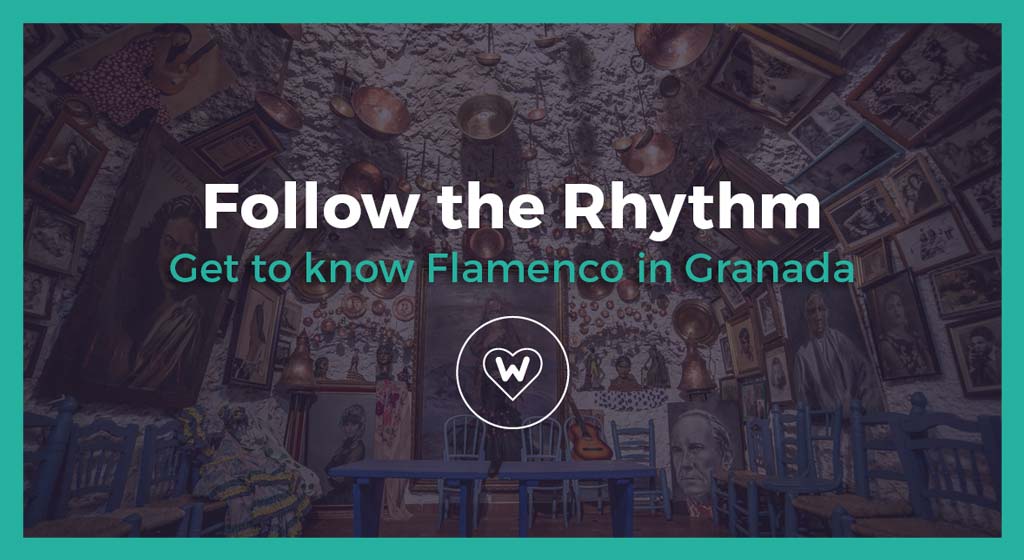7 reasons why you have to visit Granada to get to know Flamenco Art
Flamenco began to cross borders in the 19th century. At that time, many travellers, mainly Europeans, came to Granada in awe of the Alhambra, its people and the Sierra Nevada. The gypsy population was one of the main attractions. The Romantic movement admired those extremely humble people, but who lived with joy and possessed a peculiar art, flamenco.
THE SACROMONTE. MORE THAN PAINTING
Sacromonte is a small neighbourhood located on one of the slopes of the Valparaíso valley (that of the river Darro). It is characterised by its inhabitants, the mostpart of whom are gypsies and by the peculiar cave houses whitewashed cave houses.
This picturesque and idyllic placeis dotted with footpaths (pedestrian streets) that go up and down through several ravines. The changing nature makes the visit especially enjoyable in spring and autumn. Walking through its streets you can see part of the medieval wall, the Sacromonte Abbey or its water fountains.
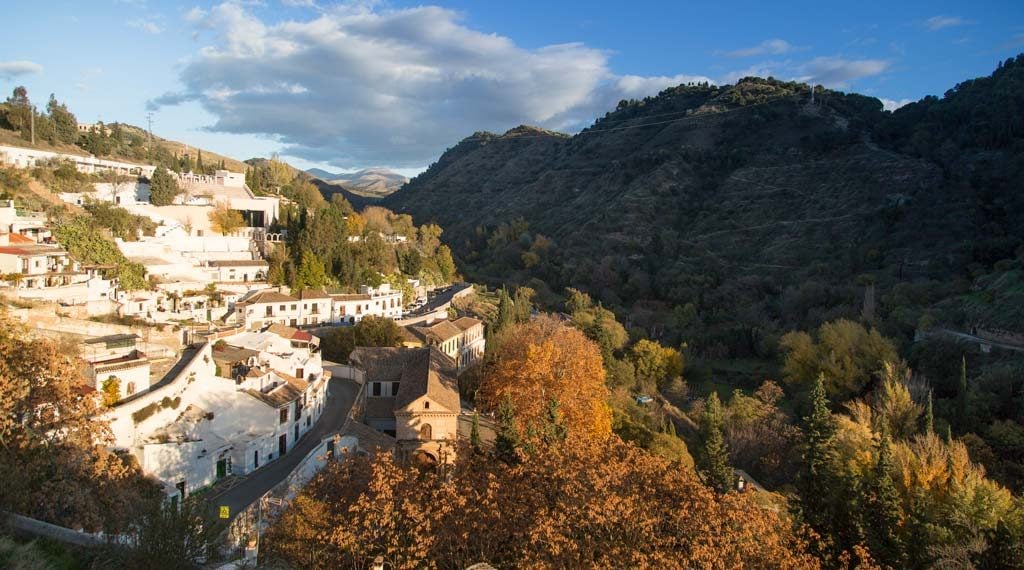
Sacromonte of Granada in autumn and in front the shady area of the Cerro del Sol with its irrigation ditches.
Another of the main attractions are the viewpoints to the Alhambra and the Cerro del SolCerro del Sol. You don’t have to look far, from almost any point the views of the Nasrid fortress are spectacular. The Cerro del Sol is located on the opposite hillside, where there were other palaces and water infrastructures that we explain in Water Paths. But the real value of this neighbourhood lies in its neighbours.
Outsiders are often struck by the large number of tablaos flamencos. For travellers, the Sacromonte district has been and still is the pinnacle of flamenco art in Granada. And although flamenco is not only a gypsy thing, the truth is that they have known better than anyone else how to channel flamenco into a way of life and business, “the tablaos”.
We recommend walking through it. Not only because it is closed to traffic for non-residents, but also because the twists and turns and narrow streets can be enjoyed on foot and it is worth spending half a day to explore them. We recommend walking around it.

Night falls on the Verea de Enmedio and the Alhambra is decked out.
LAS TABLAOS FLAMENCOS DE GRANADA
The geological substratum of conglomerates allowed the excavation of caves that were used as dwellings, artisan spaces and nowadays flamenco tablaos. Every night many buses take tourists to see Zambra performances(Granada’s most characteristic flamenco).
In the 19th century the first travellers interested in flamenco began to arrive. From then on, the gypsy people were willing to show their culture which, in time, became a way of making a living.
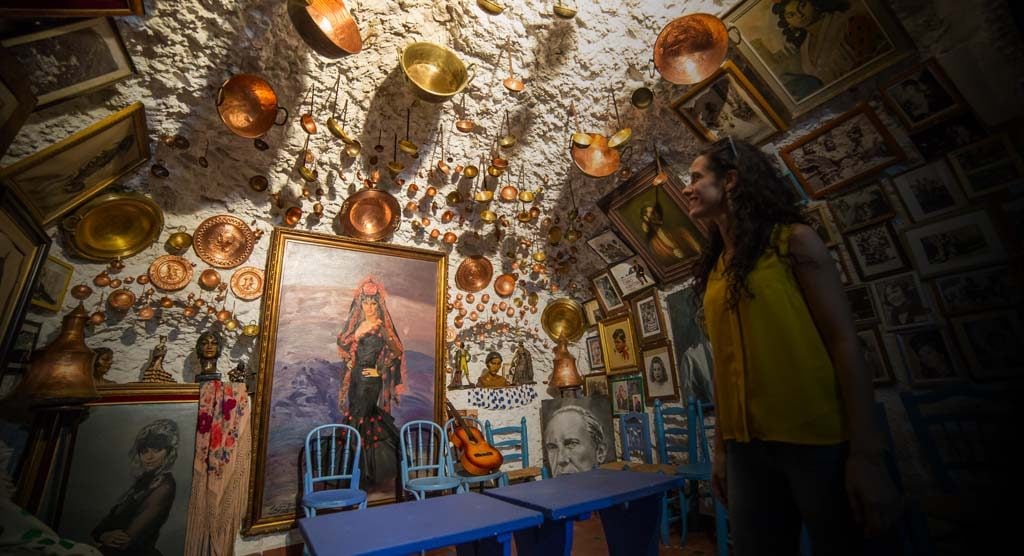
History and memories in the Cueva de Curro Albaicín in the Sacromonte of Granada.
The tablaos are caves conditioned for its visitors to enjoy singular flamenco performances. It is mainly danced by local artists.
But they are not only performance halls, they also treasure part of the history of flamenco, of the gypsies and of their neighbourhood, Sacromonte. The cave of Curro Albaicín is a good example of this.
The flamenco tablaos of Sacromonte are the best known, but there are also others outside the neighbourhood. In the Albaicín there is El Templo Flamenco, also carved into the mountain and where every night they play, dance and sing.
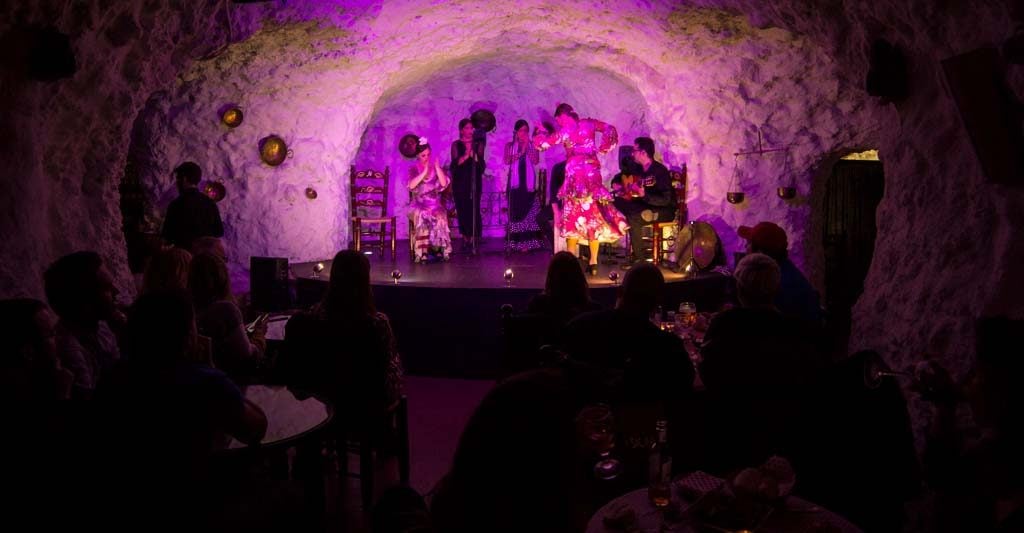
Cave of the Albaicín with flamenco tablao, El Templo Flamenco.
CUNA DE GRANDES ARTISTAS FLAMENCOS
The talent has been passed down from generation to generationforming families almost exclusively dedicated to flamenco (Amaya, Maya, Habichuela, Heredia, Morente). We tell you here about some of the best artists.
Enrique Morente is the maximum expression of flamenco from Granada. His value lies partly in the renewal of flamenco in recent decades. He introduced lyrics by great poets into his flamenco lyrics. He fused flamenco with rock and other styles in a masterful way. His figure was not without controversy among the purists, but in the meantime, his worldwide fame reached unsuspected heights.
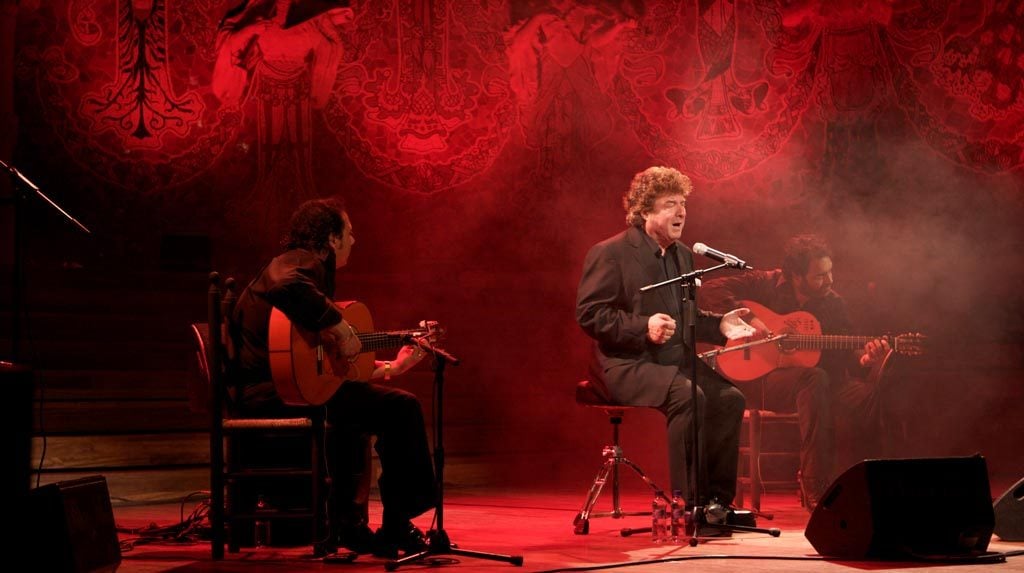
Enrique Morente at the Palau de la Música Catalana on 13 March 2009 (Alterna2. Flickr. CC BY 2.0).
Carmen Amayawas born in Granada, the international bailaora said in an interview. She says that at the age of four she danced with her family, all of whom were dancers, in front of the English in the caves of Sacromonte. The art of this woman surpassed all frontiers in the first half of the 20th century and became a myth of flamenco dancing.
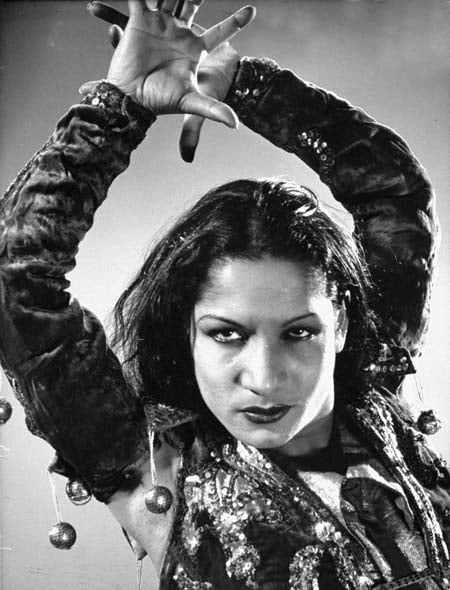
The penetrating gaze of Carmen Amaya.
María la Canastera was a singer and dancer from Sacromonte who became famous even outside Spain. At the age of 16 she travelled to Barcelona to take part in the Universal Exhibition of 1929. The Zambra, one of the purest “palos granadinos”, was her hallmark. He has a monument in Granada.
Juan Habichuela was one of the greats of the guitar. He belonged to a family with a long tradition in this instrument. He has accompanied almost all the great cantaores and bailaores (Camarón, Fosforito, Manuela Vargas, Marina Heredia, Morente, Mario Maya, José Mercé, Rancapino). He is a reference of the guitar in the second half of the 20th century.
Mario Mayawas not born in Granada and spent most of his life abroad. But he arrived here when he was only a few months old and grew up as an artist dancing in the caves of Sacromonte. Later his career became international and he danced all over the world. He is considered one of the most important flamenco dancers in the world.
Frasquito Yerbagüena was a singer from Granada in the first part of the 20th century. Amiable, talkative and with a great voice. He created a personal fandango that today bears his name, although he never recorded it. According to those who heard him, “nobody did the cante por granaínas like him”.
We mention other great artists here: The Maya brothers: Manuel “Manolete” (choreographer and bailaor) and Juan “Marote” (guitarist), María Guardia Gómez “Mariquilla” (bailaora), Estrella Morente (cantaora), Antonio Carmona (cantaor), Antonio Cuevas “El Piki” (cantaor), Marina Heredia (cantaora).
LA ZAMBRA DEL SACROMONTE
The fourth reason to get to know flamenco in Granada is the possibility of feeling the Zambra. This sensual dance has an Arabic origin, in fact it shares some characteristics with belly dancing.
It is characterised by dancing barefoot, castanets in the hands, a blouse knotted under the bust and a long skirt at the hips. These skirts have a wide flounce and pleats to make them float in the air during the dance.
In its origins it was usual to be performed at gypsy weddings. However, great dancers of the 20th century took it to the stage and today the gypsies dance it for tourists in the flamenco tablaos of Sacromonte.
It consists of three main dances: the alboreá, the cachucha and the mosca. Each of these dances represents a moment of the gypsy wedding. Curro Albaicín explains it better than us.
The Spanish Inquisition banned this tradition in the 16th century as indecent. But the Gypsies kept up their practice clandestinely. Already in the 17th century it is described as a genre belonging to the Moors of Granada.
FLAMENCO EN LA CALLE
To arrive for the first time at the Mirador de San Nicolás and be amazed by the Alhambra while flamenco is playing is priceless.
It is common to see flamenco artists stomping and singing in the street. The two main places are Plaza Nueva and the Mirador de San Nicolás, where you will find them every day. However, it is possible to see and hear other musicians in other parts of the Albaicín. These artists make a living by delighting outsiders as well as locals. They sweeten the lives of passers-by and characterise the city of Granada.
If we take into account that flamenco is an art of the people, seeing flamenco in the street should be seen as something natural. Flamenco began to reach more or less cultured stage spaces from the end of the 19th century onwards, although it has always preserved that humble and proud air.
One of our favourite street artists is Pepe Checa “El Cerrajero” and his special fusion of styles. This musician puts a special passion and feeling into improvising with his heart in the streets of Granada. We recommend visiting his Youtube channel, you are guaranteed a good time of good music.
ARTESANOS DEL FLAMENCO
The Escuela Granadina de Guitarreros is considered to be one of the best in the world. The instruments are in demand from almost anywhere in the world. This school is the largest in Spain along with the one in Madrid.
Even though the world is becoming more and more industrialised, flamenco needs craftsmen. Flamenco instruments must be created by hand in order to have the right sound and soul. The artisans are the custodians of a rich intangible heritage, a knowledge passed down from generation to generation.
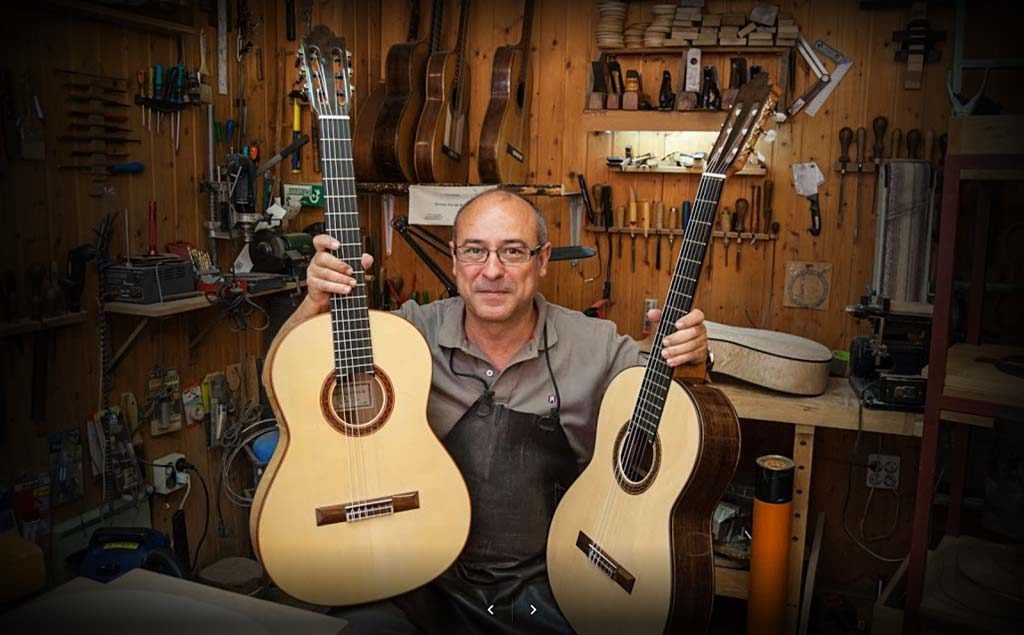
Daniel Gil de Avalle showing the fruit of his efforts. World-class guitars in Granada.
Granada has 12 artisan guitar workshops: Daniel Gil de Avalle, Guitarras Henner Hagenlocher, Eduardo Durán Ferrer, Paco Santiago Marin, Guitarreria Bellido Miguel Ángel, La Guitarrería de Ayman Bitar Serrano, Jesús Manuel Bellido Martín Belligoguitars, Guitarras Antonio Marín, Jose L. Vigil, Casa Ferrer, Victor Manuel Diaz Sánchez, Guitarrería German Perez.Guitarrería German Perez.
Some of these workshops offer visits to the workshop to learn about the working process and the passion of this craft.
FOLLOW THE COMPASS
If you want to get to know Flamenco in Granada on your own we have prepared a post that you will like “The Flamenco of the Granainos“.
But if you also want us to explain it to you, then “Follow the Rhythm“. It is a guided tour through part of the Albaicín and Sacromonte focused on getting to know the art of flamenco in Granada. Among other things, you will meet some people from the world of flamenco who will tell you about this authentic art.
